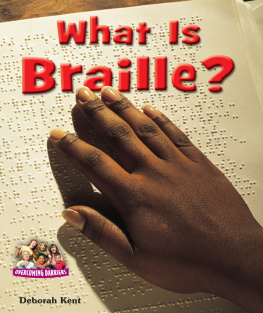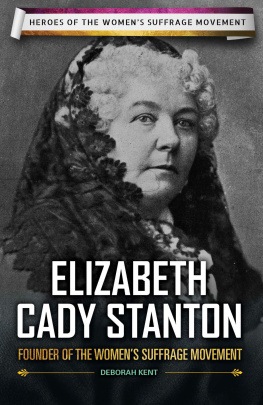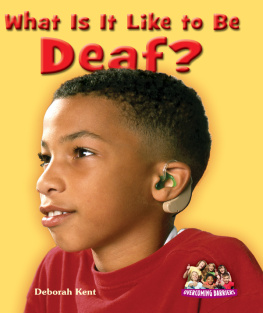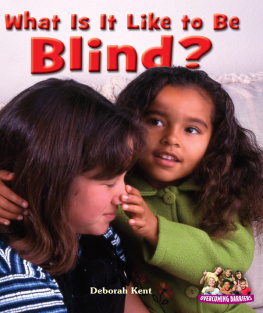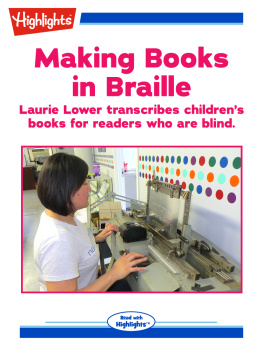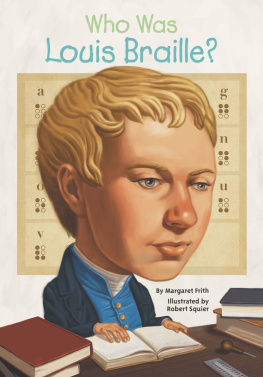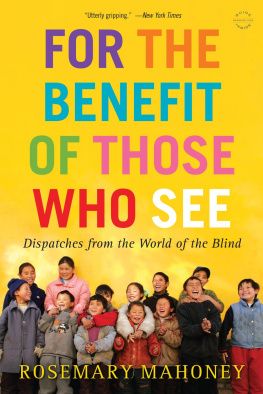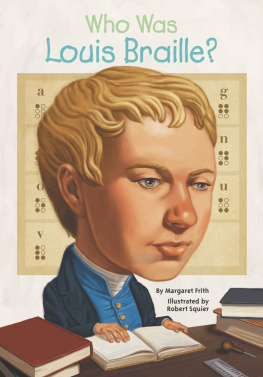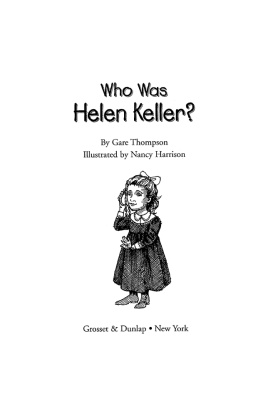FEELING THE WORDS
Many people who are blind learn Braille in order to read. This innovative code allows them to read everything from popular books to maps and signs, as well as to write their own books. Learn the history of Braille, how it has developed, and how it is used by the young people featured in this book.
Read first-hand accounts of how Braille made such a difference in the lives of individuals who are blind by bringing them a world of knowledge and information at the tip of their fingers.
Teresa Lacy, Director
Alabama Instructional Resource Center for the Blind
Alabama Institute for Deaf and Blind
Young readers will learn what life is like for blind and deaf people. These easy-to-read books will help young readers understand how some physical challenges can be overcome.
Allan A. De Fina, PhD, Series Literacy Consultant
Dean, College of Education/Professor of Literacy Education
New Jersey City University
Past President of the New Jersey Reading Association
About the Author
Deborah Kent was the first blind student in her New Jersey public school. She drew upon that experience when she wrote her first young-adult novel, Belonging. Ms. Kent has written more than twenty novels and numerous nonfiction books for children and teens. Ms. Kent also edits the magazine Future Reflections, which is written for parents and teachers of blind children.

Image Credit: Courtesy of the Ryan family
Kaitlyn and her family live on a farm. They raise animals, including goats.
Kaitlyn Ryan had two kindergarten teachers. One of them taught Kaitlyn and all the other children in her class. The other was Kaitlyns Braille teacher. She spent time with Kaitlyn by herself each day. She taught Kaitlyn to read Braille with her fingers.
Kaitlyn was born blind. She does not read by looking at a book with her eyes. She reads by using her fingers. Braille is a touch-based way to read. It is used by blind people all over the world.
Today Kaitlyn is ten. She is starting fifth grade. She is now a good Braille reader. Most of her school books are printed in Braille. She can read along with the rest of her class. They read the the words with their eyes. Kaitlyn glides her fingers over the lines on her Braille pages.

Image Credit: Courtesy of the Ryan family
Kaitlyn uses her Perkins Brailler machine to write.
Braille also helps Kaitlyn write her work. Her Braille teacher copies her work in print. This way the classroom teacher can read it.

Image Credit: ZUMA Press/Newscom
A teacher helps her student learn to use a special Braille writer.

Image Credit: Steve Black/Rex USA, Courtesy Everett Collection
This portable Braille computer helps blind people read what is on a computer screen.
Kaitlyn lives on a farm in Illinois. Her family raises corn, beans, beef cattle, and goats. Kaitlyn has raised several goats herself. She feeds and grooms them every day. One of her goats won first place in a statewide contest.
Kaitlyn loves to play outdoors. She likes to bounce on her trampoline and run around with her friends. On rainy days, however, she stays inside. Sometimes she reads or writes stories in Braille. Usually she uses a machine called a Perkins Brailler when she writes. She also has a Braille notetaker. The notetaker is like a computer with a Braille display instead of a screen. Kaitlyn knows that Braille is very useful and that it will help her throughout her life.
Lets read more about Braille and the people who use it.
Take a look at the 6 on a domino. You will see two lines of dots side by side. Each line has three dots. The Braille code uses a set of six dots, called a cell. It is set up just like the domino 6.
Each dot in the Braille cell has a number. From top to bottom, the dots on the left side of the cell are numbered 1, 2, and 3. Dots 4, 5, and 6 are on the right side of the cell.
All of the letters of the Braille alphabet are formed by using certain dots within the cell. For instance, Dot 1 alone is the letter a. Dots 1 and 2 are the letter b, and the letter c is formed with Dots 1 and 4. A letter may contain one to five dots.

Image Credit: Shutterstock.com
Each letter of the alphabet is created by using a different combination of dots.

Image Credit: Landov: Brian Snyder/Reuters
Once people learn the Braille alphabet, they are on their way to reading books in Braille. This girl is reading one of the Harry Potter books.
The Braille cell is also used to write all of the punctuation marks, such as the comma, period, question mark, and exclamation point. Numbers and musical notes can be written in Braille, too. Nearly anything that can be written in print can also be written in Braille. Altogether there are sixty-three possible combinations of the six dots in the Braille cell. Every one of them is used for something. Some combinations are used in several different ways.
Braille books are much bigger than print books. In fact, in Braille most books fill several large volumes. A Braille textbook, such as a math or science book, may come in ten or fifteen volumes, or even more. One book might fill an entire shelf in a bookcase.
To help save space, Braille uses many shortcuts. These shortcuts are called contractions. Some contractions stand for groups of letters that often occur together, such as ch, ou, ar, or ing. Some contractions are short ways of writing whole words. For instance, the letters gd stand for the word good. Afn stands for afternoon, and tm stands for tomorrow. Altogether Standard English Braille uses more than four hundred contractions.


Image Credit: Spencer Grant/Photo Edit
The Perkins Brailler machine (below) allows people to write in Braille faster than if they are using a slate and stylus (right).
There are several ways to write Braille. The Perkins Brailler is a machine with six keys. It has one key for each of the Braille dots. Letters are written by pressing the proper keys all at once. Braille can also be written by hand with a slate. A slate is a metal or plastic frame with rows of rectangular holes shaped like Braille cells. Letters are formed by punching dots with a pointed tool called a stylus. A Braille notetaker is a machine for writing Braille electronically. The machines display has tiny metal pins that move up and down. The pins form the Braille letters.

